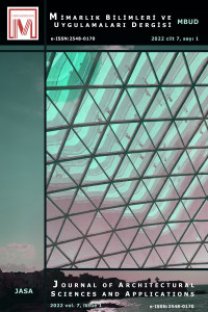Sürdürülebilir Kentleşme: Dokuma Kenti Buldan Örneği
Sürdürebilirlik, Sürdürebilir kentleşme prensipleri, Buldan
Sustainable Urbanization : a Study of a Textile Town Buldan
Sustainability, Principles of sustainable urbanization, Buldan,
___
- Anonim, (1987). Our Common Future: the Brundtland Report, World Commission on Environement and Developement, Oxford University Press.
- Attwell, K. (2000). Urban land resource and urban planting—Case studies from Denmark Landscape and Urban Planning, 52 (2000), pp. 145-163.
- Broman, G. I., Robèrt, K. H. (2017). A framework for strategic sustainable development. Journal of Cleaner Production, 140, 17-31.
- Burgess R., Carmona M., Kolstee T. (1997). The challenge of sustainable cities, Zed Books, London.
- Çal, İ. (2012). Yerel verilerin geleneksel mimari üzerindeki etkilerinin sürdürülebilirlik bağlamında karşılaştırılmalı olarak incelenmesi: Akseki-İbradı ve Piemonte-Val D’Ossola örneği.
- Desheng, X., Gengzhi H., Jingwen G., Jıarong L. (2014). Changing concepts of city and urban planning practices in guang-zhou(1949-2010): An approach to sustainable urban development.
- Ekim, D. (2004). Sürdürülebilirlik kavramı ve mimari form üzerindeki etkisi, İstanbul Teknik Üniversitesi, Fen Bilimleri Enstitüsü, Mimari Tasarım Lisansüstü Programı, Yayınlanmamış Yüksek Lisans Tezi.
- Eser, S., Dalgın, T., & Çeken, H. (2010). Sürdürülebilir kültür turizmi: Efes örneği. Ege Coğrafya Dergisi, 19(2), 27-34.
- Gazibey, Y., Keser, A., Gökmen, Y. (2014). Türkiye’de illerin sürdürülebilirlik boyutları açısından değerlendirilmesi.
- Harris, N. (1992). Wastes, the environment and the international economy, Cities, 9 (3), pp. 177-185.
- Karakurt Tosun, E. (2009). Sürdürülebilirlik olgusu ve kentsel yapıya etkileri. PARADOKS Ekonomi, Sosyoloji ve Politika Dergisi, 5(2), 1-14.
- Karakuzulu, Z. (2010). Sürdürülebilir Kentler ve Kasabalar, Yerel Gündem 21 ve Bursa Örneği. TÜCAUM VI. Ulusal Coğrafya Sempozyumu 3-5 Kasım 2010 Bildiri Kitabı, 397-406.
- Liv, H., Zhou, G., Wennersten, R., Frostell, B. (2014). Analysis of sustainable urban development approaches in China.
- Maimaitiyiming, M., Ghulam, A., Tiyip, T., Pla, F., Latorre Carmona, P., Halik, U., Sawut, M., Caetano, M. (2014). Effects of green space spatial pattern on land surface temperature: Implications for sustainable urban planning and climate change adaptation.
- Mansuroğlu, S., Kınıklı, P., Saatcı, B. (2012). Antalya’da kentsel gelişimin ekolojik açıdan değerlendirilmesi ve sürdürülebilirlik kapsamında önerilerin geliştirilmesi.
- Marcotullio, P.J. (2001). Asian urban sustainability in the era of globalization, Habitat International, 25 (4), pp. 577-598.
- May A.D., Mitchell G., Kupiszewska D., (1997), The development of the leeds quantifiable city model, P.S. Brandon, P.L. Lombardi, V. Bentivegna (Eds.), Evaluation of the built environment for sustainability, E & FN Spon, London, pp. 39-52.
- Medved, P. (2016). A contribution to the structural model of autonomous sustainable neighbourhoods: New socio-economical basis for sustainable urban planning.
- Özcan, K. (2009). Sürdürülebilir Kentsel Korumanın Olabilirliği Üzerine Bir Yaklaşım Önerisi: Konya Tarihi Kent Merkezi Örneği. METU Journal of the Faculty of Architecture, 26(2).
- Özcan, K. (2016). Kent Planlamada Sürdürülebilirlik Gündemi: Bir Kavramsallaştırma Denemesi. Avrasya Terim Dergisi, 4(2), 7-17.
- Temur, H. (2011). Edirne geleneksel konut mimarisinin sürdürülebilirlik bağlamında enerji verimliliği ve ısıl analiz açısından değerlendirilmesi, Trakya Üniversitesi, Yayınlanmamış Yüksek Lisans Tezi.
- Tosun Karakurt. E. (2013). Sürdürülebilir kentsel gelişim sürecinde kompakt kent modelinin analizi. Dokuz Eylül Üniversitesi Sosyal Bilimler Enstitüsü Dergisi, 15(1), 103-120.
- Tuğun, Ö., & Karaman, A. (2014). Çekirdek Köylerin Eko Turizme Kazandırılması İçin Sürdürülebilirlik Kavramı Çerçevesinde Bir Model. Megaron, 9(4).
- United Nations Population Fund (2007). State of world population 2007: Unleashing the potential of urban growth. United Nations Population Fund, New York.
- UN Habitat, (2009) , Urban indicator guidelines, “Better Information, Better Cities”, https://unhabitat.org
- Roy, M. (2009). Planning for sustainable urbanization in fast growing cities: Mitigation and adaptation issues addressed in Dhaka, Bangladesh, Habitat International, 33 (3) (2009), pp. 276-286.
- Shen, L., Peng, Y., Zhang, X., Wu, Y. (2012). An alternative model for evaluating sustainable urbanization. Cities, 29(1), 32-39.
- Shen, L., Zhou, J. (2014). Examining the effectiveness of indicators for guiding sustainable urbanization in China. Habitat International, 44, 111-120.
- Siiba, A., Adams, E. A., Cobbinah, P. B. (2018). Chieftaincy and sustainable urban land use planning in Yendi, Ghana: Towards congruence. Cities, 73, 96-105.
- Yigitcanlar, T., & Teriman, S. (2015). Rethinking sustainable urban development: towards an integrated planning and development process. International Journal of Environmental Science and Technology, 12(1), 341-352.
- Wu, J. (2014). Urban ecology and sustainability: The state-of-the-science and future directions. Landscape and Urban Planning, 125, 209-221.
- Yayın Aralığı: 2
- Başlangıç: 2016
- Yayıncı: Atila GÜL
Edirne Kent Ormanında Zararlı Biyotik Etmenlerin Belirlenmesi
Açelya Çağla BAKKALOĞLU, Ömer Kamil ÖRÜCÜ
Jeolojik Miras Niteliğindeki Doğal Taşların Peyzaj Tasarımında Kullanım Olanakları
Satisfaction Analysis of Recreational Quality of Erciyes Mountain Ski Centre
İşık SEZEN, Tendü Hilal GÖKTUĞ, Başak AYTATLI, Esma YIKILMAZ
